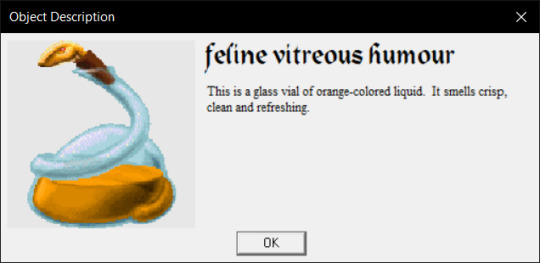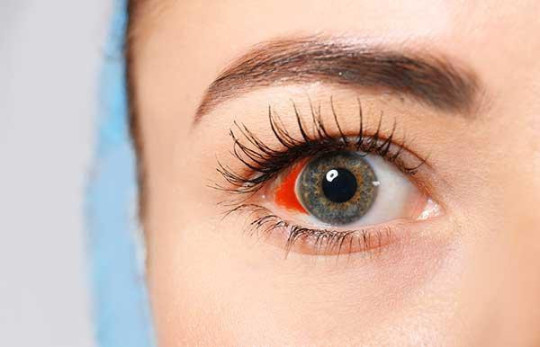#vitreous humour
Text
Scenes in a movie where people get comedically thrown through plates of glass at a saloon are an example of vitreous humour.
5 notes
·
View notes
Text

Looted From:
Narthyl Worm (10%)
Black Spider (9%)
Thrasher (5%)
1 note
·
View note
Text

Peripheral Leaking Vitreous Humour
2023
3 pages assembled into 1, graphite on archival paper
7.5” x 35”
by Bri Galan
36 notes
·
View notes
Note
Just a little question of curiousity: What would be the better option, injecting them with a syringe filled with liquified datura seeds or with an overdose of insulin.
I would inject them under their tongue while they sleep so the scar won't be found. Afterwards I would pack them up in my car and drive at least two hours away from where I live. There I would dig up a 12 feet hole, bury the victim halfway, put the corpse of a dead animal on top and close the hole.
If I'm feeling fancy I may cut up the victim's corpse and and bury them all halfway with animal caveses on top, far away from my home.
Anyways, what's the better poison for this?
This is all theoretical and for science's sake, it's a fun mental exercise to sometimes plan a murder so do not be concerned.
An usually endogenous substance like insulin that naturally exists in the body would be much harder to determine as the murder weapon, than an exogenous poison like liquified datura seeds that usually is not present in someone's body except if they have been poisoned. Insulin isn't part of regular tox screens, so if there is no suspicion no one would go looking for it. So in that case insulin would be the better choice.
It's difficult to determine and interpret insulin levels postmortem, insulin not being very stable and autolysis or hemolysis making blood as a sample impractical, which is why vitreous humour is used.
Insulin levels can be determined with immunoradiometric assay (IRMA) or liquid chromatography–tandem mass spectrometry (LC-MS/MS). In the case of natural insulin levels, it should be below the detection limit in the vitreous humour, but if the levels are increased due to poisoning it should be above the detection limit of the method, thus indicating that the death was not natural.
Another way to differentiate endogenous (your own bodie's) or exougenous insulin poisoning, is by looking at the ratio of insulin to C-peptide. During the synthesis of insulin in the body, C-peptide is cleaved from the proinsulin, which means that per formed insulin molecule there is also a C-peptide molecule formed, so with an endogenous poisoning the ratio of C-peptide to insulin should be 1:1, while if the insulin has been administered exogenously the ratio is >1 (more insulin than C-peptide).
And I am not entirely sure how you would want to create a proper solution of 'liquified datura seeds' that can be properly injected, because that would require purification and extraction of the active compounds. You can't just crush some seeds and put them into a syringe with a bit of liquid, it would clog up the needle. Meanwhile insulin already exists as solutions ready for injection, much better choice. Making such a datura seed solution would mean more effort, and would be easier to trace than insulin.
An injection under the tongue sounds uneccesary. Would be quite awkward trying to open someone's mouth while they sleep to put a syringe under their tongue, they would wake up and your plan would be foiled. And neither would it scar given scars are a healed wound and if they are dead there won't be any healing or scarring anymore.
And why bother hiding the injection site when you already plan to dispose the body anway in a way so no one would find it. Hiding injection sites is only necessary when someone finds the body, but if the body is burried and decayed there won't be any determination of an injection site when the tissue is decomposed.
But the whole process of transport and burial sounds a bit risky and could be prone to failure.
#rp#roleplay#sherlock roleplay#sherlock rp#sherlock#bbc sherlock#sherlock holmes#fictional crime#fictional crime case#fictional murder#sherlock replies#sherlock holmes roleplay#sherlock holmes rp#sherlock holmes replies#post mortem#forensic#forensics#science#biology#chemistry#crimes#detective#biochemistry#fictional death#forensic science#pathology#crime rp#crime#consulting detective
15 notes
·
View notes
Text
look man, sometimes you gotta just crush a man's eyeballs under your thumbs and feel his warm vitreous humour seeping out
20 notes
·
View notes
Text
What do you call jokes about optometrists?
Vitreous humour.
7 notes
·
View notes
Text
People out here like: Oh, you hyper fixate? That's cute!
Meanwhile my hyper fixations:
They had just refilled the bucket after nearly a week and we were both greedily drinking from it when my hand grazed his, grazed the cord he held and… and that’s when John saw the truth. His lanyard was no lanyard at all, but a braid of hair, taken from the last pit he was thrown into. He had turned her skull into pulp under the weight of the bucket. Heavy it sat filled with piles of soft, loose, dirt. That night, laid across his chest, I strangled him. But… but that is not my greatest sin. I enjoyed it, Yellow. I enjoyed taking the life from him. And as I moved my hands up to his eyes, and pushed my thumbs into his skull, feeling the soft, wet popping behind my nails and the warmth of his vitreous humour as it seeped out of his face… I knew they had won. I told John it was because he was winning, he was about to get up. That that was the quickest way for me to end him, for him to die, like a bullet through the skull, but I lied to him. I lied to John and I lied to myself… and I have been haunted by the dreams ever since.
(Id also like to note this is gonna be my theatre monologue next time I audition for a play eiduhrdfgjkbshrdfgjknb)
#john malevolent#malevolent podcast#arthur lester#hyperfixation#tw violence#why does my brain do this
43 notes
·
View notes
Text
[CLICK]
ARCHIVE: Statement of the Archive, regarding himself, their creation, and his God.
On the fourth of May, 1986, two young disciples to the Beholding were given instruction to prepare a flawless vessel for Coeus, for The One Who Seeks, for The Hungered Knowing. The disciples gathered scrolls and tablets from within an Archive in Alexandria, its Archivist watching them take the precious things all the while. It knew what needed to be done. When they had what they came for, it allowed them to take some of its vitreous humour in a syringe, and it died knowing it had fulfilled a great purpose.
They then travelled to Italy, where they found an unwilling prophet who could not stop Seeing, and took his eyes. He had plenty to spare, after all.
In the Philippines, an artefact that made people tell only truth. In Russia, the brain of a man who hoarded the secrets of others.
The disciples collected treasures from around the world for eight months, and then returned to England to complete their task.
On the second of April, 1987, Samiyah Sims gave birth in a circle of strange objects, her husband chanting and praying to their God in what would fulfil their ultimate act of faith.
On the second of April, 1987, Curiosity was made manifest.
4 notes
·
View notes
Text

Did you know that NOW never is?
The present moment is always about 11 seconds late. That’s how long it takes for light rays reflected by objects to enter the eye and pass through the cornea, lens, and vitreous humour to meet at the back of the eye upside down where the brain makes sense of this information so we see objects the right way up.
So now just was.
Right before that. And that.
And this.
2 notes
·
View notes
Text
What is Intravitreal Injection therapy and why it is used?
An intravitreal (pronounced in tra VIT re al.) injection involves injecting a medicine directly into the vitreous cavity, the area behind the eye that is filled with a gel-like substance known as vitreous humour. In an office environment, the treatment is often carried out by a qualified retina specialist. In this post, we are going to discuss what exactly it is and why it is used.
Read it out carefully:
Why is intravitreal injection used?
Age-related macular degeneration (sometimes referred to as "wet" AMD), diabetic macular oedema (leakiness resulting from diabetic damage), retinal vein occlusion (blocked blood vessels in the retina causing leakiness), inflammation or abnormal blood vessel growth related to short-sightedness, or other uncommon issues with the blood supply to the retina are among the common diseases treated with this type of injection.
Your physician will have gone through other treatment choices with you and will have given you an explanation of the benefits and drawbacks of every option. The following factors will affect these therapy options:
The reason behind your vision issue
Where in your retina is the leakiness?
What additional treatments have you had in the past, such as laser surgery if necessary or other injectable therapies for the eyes, and how have those treatments affected your eyes?
If you have gone through cataract surgery in the past
Additional factors, such as the presence of glaucoma
The majority of patients benefit in some way from intravitreal medication injections, which are often quite successful therapies. In addition to our disease-specific information pamphlets, your doctor will go through the particular risks and advantages of the course of therapy that is advised for you.
Common Diseases Treated by Intravitreal Injections
Uveitis
CME (cystoid macular edema)
Neovascular AMD
RVO (retinal vein occlusions)
Geographic atrophy in AMD
Endophthalmitis
NPDR, DME, or PDR (non-proliferative diabetic retinopathy, diabetic macular edema, or proliferative diabetic retinopathy)
CNVM (choroidal neovascular membrane) as a result of certain disorders of the retina
Risks of Intravitreal Injection
Infection is the most dangerous side effect of intravitreal injections. There is around a 1 in 5,000 chance of infection. Serious infections can result in blindness and loss of eyesight. In 10% to 20% of cases, subconjunctival haemorrhage—or bleeding on the surface of the eye—occurs. Approximately 10% of treatments result in floaters. Ten percent or so of individuals get elevated intraocular pressure after receiving long-term therapy.
Conclusion
Hope this post is useful for you, and now you know what an intravitreal injection is and why it is used. If you are looking for a specialist for your eyes and facing any kind of eye-related issue, you can connect with a professional team. If you are looking for eye surgery in Devon, you can connect with us. Here, we have experienced surgeons to offer you the best services.
#eye#Eye surgery in Devon#Eye surgeon in Devon#Retinal disease in Devon#Holistic eye care in Devon#treatment of minor eye conditions in Devon#diabetic eye carein Devon#complex cataract surgery in Devon
0 notes
Text
id drink vitreous humour but i draw the line at pee
#this is me thinking about what bodily fluids i would drinj#if its from a hot guy; all expect pee#as of currently i dont know all the fliuds in the body i think
0 notes
Text
What is Vitreous Hemorrhage?

Vitreous hemorrhage is the extravasation, or leakage, of blood into the areas in and around the vitreous humour of the eye.
Vitreous humour is the clear gel that fills the space between the lens and the retina of the eye. A variety of conditions can result in blood leaking into the vitreous humour, which can cause impaired vision, floaters, and photopsia.
For more information, consult Dr Vaidya Eye Centre the Best Eye Clinic in Andheri.
0 notes
Photo

Name: Thrasher
Max HP: 150
Karma: Evil (-75)
Resistance: Pierce, Slash, Bludgeon, Unholy, Shock.
Weakness: Fire, Holy.
Loot (drop rate):
Blue Dragon Scale (18%)
Dark Angel Feather (18%)
Purple Mushroom (16%)
Inky-Cap Mushroom (11%)
Scale Armor (8%)
Long Sword (6%)
Torch (5%)
Feline Vitreous Humour (5%)
Berserker Ring (5%)
Shilling (4%)
Mystic Sword (4%)
1 note
·
View note
Text
How does laser treatment for retinopathy work?
Surgery may be done for patients suffering from Diabetic Retinopathy if a lot of blood has been build up in a patients eye or a lot of scar tissue has caused or is causing the retina to detach from the back of the eye.
A laser is used to remove some of the vitreous humour and scar tissue. The surgery is not painful as the patient is given local anesthesia.

There are risks involved as well as discomfort when it comes to laser surgery for Diabetic Retinopathy. Sanjeevan Netralaya advanced ayurvedic eye treatment has the most effective treatment for diabetic retinopathy.
Even patients suffering from severe Diabetic Retinopathy and have lost hope with regular medicine have found improvement in their condition without having to go through any pain.
Sanjeevan Netralaya treats patients with unique tailor made treatments after understanding their entire history making sure that every patient gets the most customized and effective treatment for their problems.
#diabetic retinopathy#eye diseases#diabetic#eye health#eyes#blue eyes#eyesight#age related macular degeneration treatment#ayurvedic treatment#ahmedabad#retina#retina centers#india
0 notes
Text
Vitreous Haemorrhage ?
A Vitreous Haemorrhage is a disorder in which the vitreous humour, the transparent gel-like fluid that fills the posterior chamber of the eye, bleeds. Numerous factors, including diabetes, hypertension, and ocular damage, may contribute to this. The abrupt onset of floaters, a reduction in vision, and occasionally light flashes are signs of a vitreous haemorrhage. Depending on the origin and extent of the bleeding, there are many treatment options. Depending on the situation, surgery may be required to remove the blood and correct any underlying damage. In some instances, the blood may be absorbed by the body naturally.Read More
1 note
·
View note
Text
HYPEROPIA AND IT'S DIFFERENT TYPES
Hyperopia
What is ‘Hyperopia’ or ‘Far-Sightedness’? People who have hyperopia can focus on distant objects but cannot clearly view objects in the near distance. The rays of light come to a focus behind the retina.
What are the causes of Hyperopia? The cause of hyperopia is the failure of the lens to return to its normal rounded shape. Hyperopia is also caused by the eyeball being too short. Both these conditions result in the image being focused on a point behind the retina.
Different types of hyperopia include
Axial hyperopia This condition occurs when the antero-posterior diameter of the eye is too short and the retina is too near the optical system.
Curvature hyperopia– This condition occurs when the curvature of the cornea or the lens is too flap.
Index hyperopia– This condition occurs under any of the following circumstances.
The refractive index of the aqueous humour is too low.
The refractive index of the vitreous humour too high or
The refractive index of the lens is too low.
The absence of the crystalline lens in its normal position in the eye causes high hyperopia which is also called ‘aphakia’.
Symptoms that indicate hyperopia
Blurring of vision for close work
Eyestrain
Headache
Muscular fatigue, the symptom of eyestrain
Treatments for hyperopia There are a variety of correctional methods for hyperopia. These include
Spectacles Convex Glasses
Contact lenses – Soft & Gas Permeable
Laser surgery for Hyperopia – Lasik & Custom LASIK
Phakic Intra Ocular Lens – ICL & Phakic & Verisyse Intra Ocular lens
Refractive Lensectomy
In the hypermetropic LASIK procedure
The doctor first creates a thin protective flap of corneal tissue using an instrument called the Microkeratome or by using Intralase femtosecond laser (blade-free LASIK).
He gently lifts this flap, thereby exposing the deeper corneal layers.
He then removes the tissue from the central and and mid-peripheral portion of the cornea with an Excimer laser.
This steepens the central corneal curve, refocusing light back on to the retina.
He gently replaces the protective flap, where it heals naturally and securely.
This procedure is quick, painless and in most cases you can return to your normal activities very quickly, usually within hours.
TAG- Best Lasik Hospital In Mumbai, Best Lasik Eye Surgeon In Mumbai, Best Doctor For Lasik Surgery In Mumbai
ABOUT DOCTOR - https://medicalcaree.blogspot.com/p/eye-specialist.html
TO KNOW MORE - https://www.lasikindia.com/
0 notes